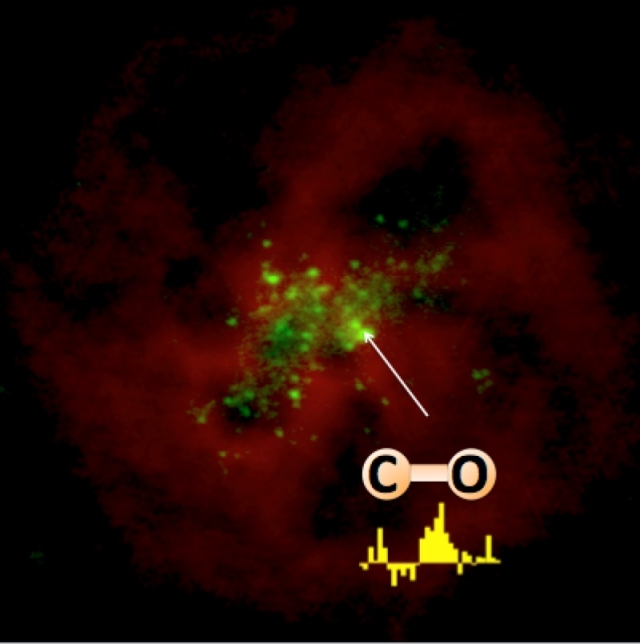Professor Shi Yong and his team, for the first time in human history, detected carbon monoxide (CO) gas in extremely-metal-poor galaxies and thus provided evidence for the existence of molecular gas in these galaxies, reported the international journal Nature Communications on December 9, 2016 (see:http://www.nature.com/articles/ncomms13789).
Such research will promote the understanding of the formation of the first stars and galaxies because the extremely-metal-poor galaxies came into being in the early universe and have hardly had evolutions ever since.
Stars in the Milky Way Galaxy including our Sun were formed during the inward collapse of the molecular gas under the gravitation. Different from ionized gas and atomic gas, molecular gas can cool down to much lower temperature (20K), and with the decline of the temperature, it is gradually contracting and its internal pressure is lower than its gravitation, resulting in the formation of a high-density ball of gas, which is a star.
As astronomical observation shows, new stars are indeed forming in the metal-poor galaxies, but are these stars formed by molecular gas or by atomic gas as predicted by some theoretical models? This question is directly related to the issue of formation of stars in the early universe, an issue unsettled by scientists for a dozen years.
Detecting carbon monoxide (CO) is crucial for seeking evidence of the presence of molecular gas. Although the main elements of molecular gas are hydrogen molecules and helium atoms, they have no electromagnetic radiation that is astronomically observable.
Carbon monoxide (CO) is the third most abundant element of molecular gas next to hydrogen molecules and helium atoms, and its molecular line emission is mainly at 3mm band. Over the past decades, research teams in the world have used different telescopes (IRAM 30m, PdBI, CARMA and ALMA) to detect the emission of carbon monoxide (CO) in metal-poor galaxies, but all to no success.
Professor Shi Yong’s team started to search for carbon monoxide (CO) in 2014 and in 2015, published their initial result in the American journalAstrophysical Journal. Their efforts failed even though the sensitivity the used had improved several times over the past.
Last March, however, Shi and his collaborators obtained the right of 60-hour use of the IRAM 30m telescope in Spain and finally succeeded in detecting carbon monoxide (CO) in a metal-poor galaxy.

The galaxy DDO 70 (shown in the picture) has a metallicity only 7% of the solar metallicity, which meets the tradition criterion for metal-poor galaxies (lower than 10% of the solar metallicity). Professor Shi Yong together with Wang Junzhi, researcher from Shanghai Astronomical Observatory, has spent about ten days making astro-observation by IRAM 30m. The cold weather created a good condition for observation, and they finally detected the rotational level 2->1 of CO molecule radiation (see the spectrum in the lower right corner of the above picture).
This was the first time scientists in the world detected CO in metal-poor galaxies, and it provides direct evidence that molecular gas is present at a very low metallicity, supporting the prediction that stars in metal-poor galaxies are formed by molecular gas rather than by atomic gas as having been speculated by some theoretical models.
The authors of theNature Communications paper include Shi Yong (professor at Nanjing University, the first and the corresponding author), Wang Junzhi (researcher of Shanghai Astronomical Observatory, Chinese Academy of Sciences), Zhang Zhiyu (University of Edinburgh), Gao Yu (researcher of the Purple Mountain Observatory, Chinese Academy of Sciences), Gu Qiusheng (professor of Nanjing University), and Hao Caina and Xia Xiaoyang (professors of Tianjing Normal University). Their research received the support from the National Science Foundation of China, the Ministry of Science and Technology, the Science Foundation of Jiangsu Province and the Chinese Academy of Sciences.
Source: Office of Science and Technology, School of Astronomy & Space Sciences